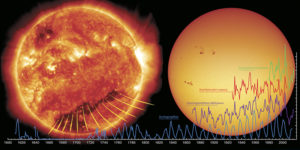by N. Scafetta, July 6, 2023 in Andy May Blog
Although the sun provides nearly all the energy needed to warm the planet, its contribution to climate change remains widely questioned. Many empirically based studies claim that it has a significant effect on climate, while others (often based on computer global climate simulations) claim that it has a small effect.
The Intergovernmental Panel on Climate Change (IPCC) supports the latter view and estimates that almost 100% of the observed warming of the Earth’s surface from 1850–1900 to 2020 was caused by man-made emissions (AR6 WG1, pages 63, 425, and 962). This is known as the anthropogenic global warming (AGWT) theory.
I addressed this important paradox in a new study published in Geoscience Frontiers. The conundrum appears to arise from two sets of uncertainties: (i) the historical decades and long-term variations in solar activity are unknown; (ii) the sun may affect Earth’s climate through various physical mechanisms many of which are not fully understood and are not incorporated into the global climate models (GCMs).
It is important to notice that the AGWT is based solely on computer global climate model simulations that use total solar irradiance (TSI) records with very low multidecadal and long-term variability. The models also assume that the sun affects the climate system only through radiative forcing, although there is evidence that other solar processes related to solar magnetic activity (solar wind, cosmic rays, interplanetary dust, etc.) also affect the climate.
The total solar irradiance (TSI) records
…
…


